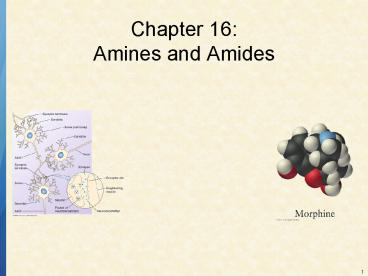Chapter 16: Amines and Amides - PowerPoint PPT Presentation
1 / 28
Title:
Chapter 16: Amines and Amides
Description:
Amines are derivatives of ammonia, NH3, where one or more hydrogen atoms have ... Name by changing 'amine' to 'ammonium' and adding the anion name. ... – PowerPoint PPT presentation
Number of Views:1672
Avg rating:3.0/5.0
Title: Chapter 16: Amines and Amides
1
Chapter 16Amines and Amides
2
- AMINES
- Amines are derivatives of ammonia, NH3, where one
or more hydrogen atoms have been replaced by an
organic (R) group.
3
- COMMON NAMING FOR AMINES
- Alphabetically link the names of the alkyl or
aromatic groups bonded to the nitrogen and attach
the suffix amine so the name is one word. - Use di- or tri- prefixes for identical alkyl
groups. - Examples
4
- IUPAC NAMING FOR PRIMARY AMINES
- The NH2 group is treated as a chain substituent
called the amino group. - Examples
5
- IUPAC NAMING FOR AMINES
- Name the longest chain attached to the nitrogen.
- Replace the final e with amine.
- Number the chain so the carbon bonded to the
nitrogen has the lowest possible number. - Number the other substituents on the carbon
chain. - An italic N is used as a prefix for a
substituent on nitrogen. - Examples
6
- NAMING AROMATIC AMINES
- Aniline is the simplest aromatic amine.
- Compounds are named as substituted anilines.
- An italic N is used to indicate that an alkyl
group is attached to the nitrogen and not to the
ring. - Examples
7
- PHYSICAL PROPERTIES OF AMINES
- The N-H bond is not quite as polar as the O-H
bond. - Primary and secondary amines can form hydrogen
bonds between molecules. - The hydrogen bonds are not as strong as those of
alcohols, so amine boiling points are somewhat
lower than those of alcohols.
8
- PHYSICAL PROPERTIES OF AMINES, cont.
9
- PHYSICAL PROPERTIES, cont.
- Amines can hydrogen bond with water, making
smaller amine molecules usually water soluble.
10
- AMINE REACTIONS
- All amines behave as weak bases in water (similar
to ammonia) - R-NH2 H2O ? R-NH3 OH-
- Examples
- CH3-NH-CH2CH3 H2O ? CH3-NH2-CH2CH3 OH-
- methylethylamine methylethylammonium
ion
11
- AMINE REACTIONS, cont.
- All amines behave as weak bases and form salts
when they react with acids such as HCl. - R-NH2 HCl ? R-NH3Cl-
- amine acid amine salt
- Example
12
- AMINE SALTS
- Name by changing amine to ammonium and adding
the anion name. - More water soluble than parent amine, a useful
characteristic for administering amine drugs - Can be converted back to amine form
- Quaternary ammonium salts have four alkyl groups
attached to the nitrogen.
13
- AMIDE FORMATION
- Amines react with acid chlorides or acid
anhydrides to form amides.
14
- AMIDE FORMATION, cont.
- Primary and secondary amines can form amides.
- Tertiary amines do not react to form amides.
15
- Examples
16
- POLYAMIDE FORMATION
- Reaction of diacid chlorides with diamines
produces polyamides that, like polyesters, are
condensation polymers. - The repeating units in polyamides are held
together by amide linkages. - 3 billion pounds of nylon and related polyamides
produced annually - Proteins are polyamides ( e.g. silk and wool)
17
- AMINE NEUROTRANSMITTERS
- Neurotransmitter a chemical bridge between
nerve cells
18
- IMPORTANT AMINE NEUROTRANSMITTERS
- Acetylcholine
- Dopamine synthesized from the amino acid
tyrosine - Norepinephrine synthesized from dopamine, may
be associated with mental illness - Serotonin synthesized from the amino acid
tryptophan, may be associated with mental illness
19
- OTHER BIOLOGICALLY IMPORTANT AMINES
- Epinephrine (adrenaline) more important as a
hormone than a neurotransmitter - Fight-or-flight hormone, released in response to
pain, anger, or fear, increases blood glucose
level for energy
20
- OTHER BIOLOGICALLY IMPORTANT AMINES, cont.
- Amphetamines nervous system stimulants, similar
in structure to epinephrine - Abuse of amphetamines has severe detrimental
effects on the body and the mind
21
- OTHER BIOLOGICALLY IMPORTANT AMINES
- Alkaloids a class of nitrogen-containing
organic compounds obtained from plants. - Examples include
- Nicotine found in tobacco
- Caffeine found in coffee and cola drinks
- Quinine used to treat malaria
- Opium used to make codeine (in cough
medicines), morphine (pain killer), and heroin
22
- NAMING AMIDES
- Use the carboxylic acids name and drop the ic
ending (common name) or oic ending (IUPAC name)
and change to amide. - Examples
23
- NAMING AMIDES
- Use N to denote alkyl groups attached to the
nitrogen atom. - Examples
24
- PHYSICAL PROPERTIES OF AMIDES
- Hydrogen bonding between unsubstituted amides
causes them to have high melting points.
25
- PHYSICAL PROPERTIES, cont.
- Amides can form hydrogen bonds with water, making
smaller amide molecules rather water soluble.
26
- AMIDE REACTIONS
- Amides are neither acidic nor basic.
- Hydrolysis the reverse of amide formation, an
amide is cleaved to produce a carboxylic acid and
an amine or ammonia - Amide hydrolysis is a central reaction in the
digestion of proteins and the breakdown of
proteins within cells. - In the body, this hydrolysis is catalyzed by
enzymes.
27
- AMIDE REACTIONS HYDROLYSIS, cont.
- The products of an amide hydrolysis depend on
whether the reaction occurs in acidic or basic
conditions.
28
- Specific Examples

